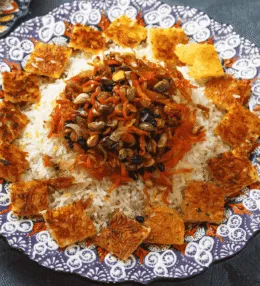
- View
Table of Contents
ToggleSuman is a Filipino delicacy that manages to feel both festive and every day at the same time. It is made from glutinous rice cooked gently with coconut milk, then wrapped in banana or palm leaves. The result is a soft roll that is steamed and enjoyed on its own or with a sprinkle of sugar.
It is a food that you often find at local markets and family gatherings, always ready to be eaten by hand with no need for plates or fuss. The leaf wrapper gives it a natural fragrance, and the texture makes it very satisfying to bite into slowly.
While sweet treats come in many forms in the Philippines, suman holds a place that is truly its own. It is unpretentious and simple, yet full of comfort and memory, the kind of food that always brings people back to the table.
Want to dive deeper into Filipino Cuisine? Don’t miss our post on 28 Traditional Filipino Foods to Try
What Is Suman?
Suman is essentially a sticky rice roll, but it is so much more than its ingredients. The glutinous rice is soaked, simmered with coconut milk, sometimes lightly sweetened, and then carefully packed into softened leaves.
The rolls are steamed until the rice is tender and infused with a light aroma from the leaves. Some suman is served plain, while others are topped with grated coconut or eaten with latik, a thick syrup made from coconut milk.
It is eaten throughout the year, but you will see more of it during celebrations and holidays. Its versatility means that it can be a snack, a light breakfast, or a dessert to share after a meal, depending on how it is served.
Ingredients and Taste
The main ingredient in suman is glutinous rice. This variety of rice has a natural stickiness that binds together when cooked. Coconut milk is the second essential ingredient, giving a rich flavour and a soft, creamy finish.
Banana or palm leaves are used to wrap the rice before steaming, and they add their own subtle fragrance. Some versions include a little sugar, while others rely on toppings such as latik or grated coconut for sweetness.
The taste is delicate and comforting. It is not overly sweet, so it pairs well with coffee or hot chocolate. The coconut gives it a light richness, while the leaves lend an earthy aroma that sets it apart from other rice cakes.
A Taste of History
Suman has been part of Filipino food traditions for centuries. It has roots in a time when rice farming shaped the rhythm of life, and families created simple ways to cook and preserve rice using what was around them.
Wrapping rice in leaves was a practical solution that turned into a culinary signature. It allowed the food to be transported and shared easily, which is why suman remains a staple during community gatherings and long journeys.
The dish varies by region, with some areas using cassava instead of rice and others adding native chocolate, ginger or brown sugar. These regional touches reflect the diversity of the Philippines while keeping the spirit of suman intact.
Today, suman is more than a sweet treat. It represents the idea that food can be humble and deeply rooted in tradition yet still feel special. With each bite you taste both the rice fields and the culture that has kept this delicacy alive for generations.
How to Make Suman (Sticky Rice Roll)
Suman is a cherished Filipino delicacy made from sticky rice and coconut milk, gently wrapped in banana leaves and steamed until tender. The aroma of banana leaves infuses the rice, giving a unique taste that is simple yet deeply comforting. See the recipe card at the bottom for printable directions
Ingredients
For the rice mixture
- 2 cups glutinous rice (malagkit), soaked for 3 hours
- 1 ½ cups thick coconut milk
- ¾ cup brown sugar
- 1 tsp salt
For wrapping
- 8 large banana leaves (washed and softened over heat)
For serving
- Ripe mango slices or grated coconut (optional)
Cooking Instructions
Step 1: Prepare the banana leaves
To begin, wash the banana leaves thoroughly. Pass each leaf briefly over an open flame or a hot dry pan to soften them and prevent tearing. Cut into rectangles about 25 cm by 20 cm. Move to cooking the rice mixture.
Step 2: Cook the sticky rice
Drain the soaked glutinous rice. In a heavy pan, combine coconut milk, brown sugar, and salt. Stir over medium heat until the sugar dissolves and the mixture just starts to simmer. Proceed to the next step quickly before the coconut milk thickens.
Step 3: Combine rice with coconut milk
Add the drained rice into the simmering coconut mixture. Stir continuously until most of the liquid is absorbed and the rice is half cooked, about 10 minutes. The grains should still be firm. Transfer to a plate to cool slightly before wrapping.
Step 4: Prepare for wrapping
Lay one banana leaf flat. Place about 4 tablespoons of the coconut rice mixture on the centre. Shape into a log about 10 cm long. Move to wrapping.
Step 5: Wrap the suman
Fold the banana leaf lengthwise over the rice, then fold the ends securely to form a neat parcel. Tie with kitchen twine if necessary. Repeat with remaining rice. Move to steaming.
Step 6: Steam the parcels
Arrange the wrapped suman in a steamer basket. Steam over medium heat for 45 to 50 minutes, or until the rice is fully cooked and tender. Transition to cooling before serving.
Step 7: Cool slightly
Once cooked, remove the suman from the steamer and allow to cool slightly so the flavours settle and the parcels firm up. Proceed to serving.
Final step: Serve and enjoy
Serve warm or at room temperature. Traditionally enjoyed on its own, suman is often paired with fresh mango or sprinkled with grated coconut for added richness. Presentation tip: Serve in the leaf for an authentic rustic look.
Variations and substitutions
- Use white sugar instead of brown sugar for a lighter flavour.
- If banana leaves are unavailable, use food safe parchment paper lined with a thin layer of foil, though the traditional aroma will be absent.
- Add a hint of vanilla or a pandan leaf to the coconut mixture for a fragrant variation.
Cooking Tips for Perfect Suman
- Soak glutinous rice for at least 3 hours to ensure even cooking.
- Avoid overcooking the rice before wrapping; it will finish cooking during steaming.
- Always soften banana leaves before wrapping to prevent tearing.
- Let suman cool slightly before unwrapping for a firmer texture.

Filipino Suman (Sticky Rice Roll)
Ingredients
For the rice mixture
- 2 cups glutinous rice malagkit, soaked for 3 hours
- 1 ½ cups thick coconut milk
- ¾ cup brown sugar
- 1 tsp salt
For wrapping
- 8 large banana leaves washed and softened over heat
For serving
- Ripe mango slices or grated coconut optional
Instructions
- To begin, wash the banana leaves thoroughly. Pass each leaf briefly over an open flame or a hot dry pan to soften them and prevent tearing. Cut into rectangles about 25 cm by 20 cm. Move to cooking the rice mixture.
- Drain the soaked glutinous rice. In a heavy pan, combine coconut milk, brown sugar, and salt. Stir over medium heat until the sugar dissolves and the mixture just starts to simmer. Proceed to the next step quickly before the coconut milk thickens.
- Add the drained rice into the simmering coconut mixture. Stir continuously until most of the liquid is absorbed and the rice is half cooked, about 10 minutes. The grains should still be firm. Transfer to a plate to cool slightly before wrapping.
- Lay one banana leaf flat. Place about 4 tablespoons of the coconut rice mixture on the centre. Shape into a log about 10 cm long. Move to wrapping.
- Fold the banana leaf lengthwise over the rice, then fold the ends securely to form a neat parcel. Tie with kitchen twine if necessary. Repeat with remaining rice. Move to steaming.
- Arrange the wrapped suman in a steamer basket. Steam over medium heat for 45 to 50 minutes, or until the rice is fully cooked and tender. Transition to cooling before serving.
- Once cooked, remove the suman from the steamer and allow to cool slightly so the flavours settle and the parcels firm up. Proceed to serving.
- Serve warm or at room temperature. Traditionally enjoyed on its own, suman is often paired with fresh mango or sprinkled with grated coconut for added richness. Presentation tip: Serve in the leaf for an authentic rustic look.
Nutrition
You May Also Like







Leave a Review